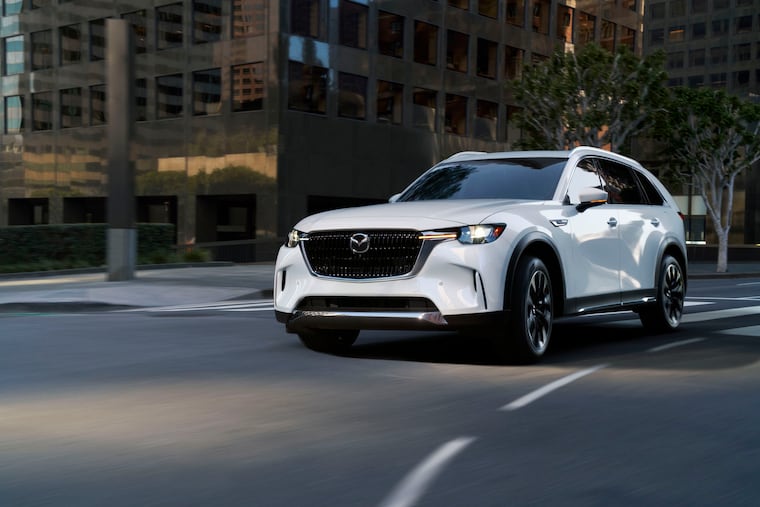The 2024 Mazda CX-90 PHEV is bigger and more efficient, but still a compromise
The CX-90 vastly improves over the CX-9, but seat comfort and cruise control response remain issues. Add in just so-so handling, and it’s hard to find a reason for the Mazda.

2023 Toyota Sequoia 4WD TRD Pro Hybrid vs. 2024 Mazda CX-90 PHEV Premium Plus Package: Two wildly different ways to behemoth.
This week: 2024 Mazda CX-90.
Price: $58,920 as tested.
Conventional wisdom: Car and Driver likes that it’s “quicker than the turbo six,” with a “useful EV range, quick recharging,” but not that it has “some powertrain missteps, marginal third row,” and that its “steering falls short of the Mazda norm.”
Marketer’s pitch: “Engineered to fit your lifestyle.”
Reality: A nice vehicle, but not without its drawbacks.
Pleased to meet you: The CX-90 debuted for the 2023 model year at the large end of Mazda’s lineup. It replaces the CX-9, Mazda’s very hungry smaller three-row SUV.
Mazdas have never had an attractiveness problem like some automobiles — I’m glaring at you, Toyota and Lexus — and the CX-90 definitely catches the eyes even more. The shape alone resembles a BMW X7 or even a Land Cruiser, with a long hood and a lot of big box in the rear.
Competition: In addition to the Toyota Sequoia (not really), there’s the Kia Telluride, Hyundai Palisade, Toyota Grand Highlander, and Honda Pilot.
Friends and stuff: The CX-90 definitely outclasses the CX-9 for space. I found the third row to be fairly roomy for an SUV, with snug leg and knee room. Headroom was pretty good.
The second-row captain’s chairs slide back and forth and sit upright, so plenty of room can be had there for most occupants. The seats themselves are supportive, but I wouldn’t call them comfortable; they’re kind of narrow and kitchen-chairlike.
The middle seats move to make easy access to the rear, but clambering around between the seats is possible as well.
Cargo space is 15.9 cubic feet behind the third row, 40.1 behind the second, and 75.2 with everything folded, not too far from the Sequoia.
Towing maxes out at 3,500 pounds.
Up to speed: The 2.5-liter four-cylinder gets a 17.8-kw battery added to the mix, and together they create 323 horses. The CX-90 gets to 60 mph in 6.2 seconds, according to Motor Trend.
In normal driving, I could never feel this athleticism. The CX-90 always felt like it was lumbering from stop to full speed. But toward the end, I really pushed it and found the CX-90 does live up to those numbers; it can haul butt pretty nicely.
Other versions of the CX-90 get a mild hybrid with a six-cylinder turbocharged engine with a 48-volt electrical system that produces 280 horsepower or 340, depending on the trim.
Shifty: The gear selector is new to Mazda. The T-bar handle shifts left and right for Park and Reverse, and pulls backward for Drive.
Shifting of the 8-speed is only available via paddles and only outside EV mode.
Something about the transmission or the drivetrain left the CX-90 feeling lurch-y an awful lot. When shifting from electric to gas, or even sometimes while just running on gasoline, there seemed to be a lot of jostling when I accelerated.
The shifter does tend to get caught on phone charger cables frequently.
On the road: The first thing I should have done was turn off the lane keeping. The CX-90 acts like some older Kia and Hyundai models, in that the lane keeping would render handling vague and off kilter.
Once I recognized that was my problem, I found country roads easier to handle. They were never exactly enjoyable but they were OK.
Steady speed: The CX-90′s adaptive cruise annoyed me to no end. It registered all kinds of interference with vehicles from other lanes, but it would not slow down for curves, something most other brands have perfected lately.
Driver’s Seat: Mazda seats and I don’t always get along, and the CX-90 was no exception. The lumbar and overall feel of the seat were good, but I still couldn’t help feeling like the seat bottom needed some support dialed out of the center. It felt like there was a lumbar control there, where there of course was not.
The gauges include a digital speedometer readout and dials showing how power is used and fuel and charge remaining.
Play some tunes: The touchscreen is a large 12.3-inch unit, thanks to the free Premium Plus Package, although Mazda keeps the console dial for operations as well.
The Bose sound system was pretty clear and true to the music’s origins, but the CX-50 has better overall sound. The surround does help but it’s not all that in this model. Call it an A-.
Keeping warm and cool: The HVAC is controlled via buttons underneath the infotainment screen, but toggles control the temperature. Strangely, press down on the red one for hotter and down on the blue one for cooler, instead of a typical “up = hot, down = cold” setup.
Fuel economy: I averaged a delightful 31 mpg. The EV provides about 25 miles before switching to the engine. I could have gotten those numbers higher if I’d found a charger at the Rehoboth hotel where we stayed.
This is the biggest improvement over the piggish CX-9.
Where it’s built: Hofu, Japan.
How it’s built: Consumer Reports rates the CX-90 PHEV reliability at 3 out of 5.
In the end: Both the CX-90 and the Sequoia have their drawbacks. It’s the Telluride or the Palisade in the three-row category. The Acura MDX is cool if you have some extra money.
If I needed something big, I’d probably just sell the boat or the camper.